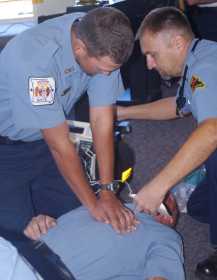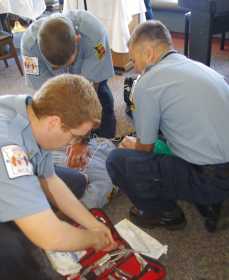When every minute counts

As the Nevada Rotary Club listened to a presentation about the Vernon County Ambulance District, EMT Dustin Miller collapsed on the floor, beginning his role as the mock victim of a heart attack -- full-blown cardiac arrest. Voices echoed, "Call 911," and in short order a medical rescue team appeared in hope of saving their "victim."
Normally, said VCAD Paramedic Brett Piene, it can be 5-6 minutes before the ambulance gets on it's way. First, the call goes to the dispatcher, and a moment is spent determining the needs of the caller, then EMS workers are paged and respond to the emergency. After that, it's only a minute or two to many locations in Nevada, but can be as much as 25 minutes before the ambulance reaches some outlying locations in Vernon County.
The responders re-enacting the cardiac arrest event went immediately to work; checking whether he was breathing and whether or not the victim's heart was beating. This time, there were three workers at the "scene," which may or not be the case in real life. Two people staff the ambulance; but Vernon County Ambulance District also enlists the help of first responders, volunteers who are trained in many aspects of first aid, who are often closer to the emergency site than the ambulance crews on duty. About 80-90 percent of the time, these first responders are able to help, making three on the scene a realistic scenario.

Paramedic Michael Forquer gave verbal cues to his medical teammates; meanwhile, EMT Justin Hueston began a series of procedures simulated in the demonstration, including intubation, intravenous drug administration and defibrillation, with the assistance of EMT Kaleb Bishop.
In the scenario, the victim's heart was restarted and the patient was loaded onto a stretcher to be taken to an appropriate medical facility.
Not every heart attack is a full-blown cardiac arrest; nevertheless, cardiac issues also can be identified on a monitor. When a heart attack occurs, cardiac patients can now be transported directly to a facility that has a cardiologist on staff, which can save valuable time for the patient. "That time saves heart muscle," Piene said.
Sometimes, too, it takes a few moments for the ambulance to get rolling once the patient is inside, because the patient is getting more care then, McKenzie noted.
In Vernon County, VCAD has responded to 250 cardiac-related calls this year; 25 of them have been cardiac arrest, said VCAD Director James McKenzie; and Vernon County -- both the ambulance district and much of the community -- is well prepared for such emergencies. There are 26 Automated External Defibrillators at schools, medical clinics and in the hands of first responders in the county that can be used for early defibrillation, something the American Medical Association says is vital in treating cardiac arrest. Defibrillation devices and other costly equipment, such as monitors that can electronically send information to a cardiologist or facility, and more are on the district's ambulances.
The ambulance district also is always seeking new first responders and regularly offers first-responder training. The district also routinely teaches CPR to about 150 people each year. For more information about being a first responder, contact the Vernon County Ambulance District at (417) 667-5079.
